Input interpretation

NH_4NO_3 ammonium nitrate ⟶ H_2O water + NO nitric oxide + N_2 nitrogen
Balanced equation
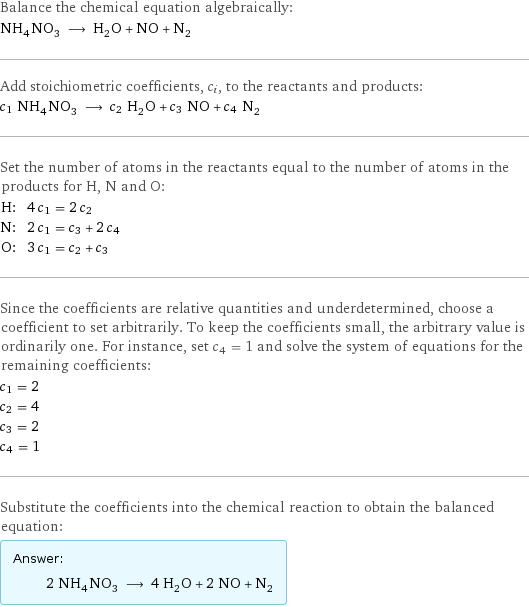
Balance the chemical equation algebraically: NH_4NO_3 ⟶ H_2O + NO + N_2 Add stoichiometric coefficients, c_i, to the reactants and products: c_1 NH_4NO_3 ⟶ c_2 H_2O + c_3 NO + c_4 N_2 Set the number of atoms in the reactants equal to the number of atoms in the products for H, N and O: H: | 4 c_1 = 2 c_2 N: | 2 c_1 = c_3 + 2 c_4 O: | 3 c_1 = c_2 + c_3 Since the coefficients are relative quantities and underdetermined, choose a coefficient to set arbitrarily. To keep the coefficients small, the arbitrary value is ordinarily one. For instance, set c_4 = 1 and solve the system of equations for the remaining coefficients: c_1 = 2 c_2 = 4 c_3 = 2 c_4 = 1 Substitute the coefficients into the chemical reaction to obtain the balanced equation: Answer: | | 2 NH_4NO_3 ⟶ 4 H_2O + 2 NO + N_2
Structures
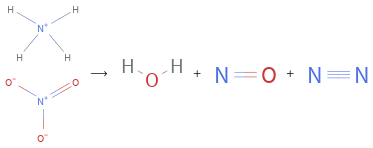
⟶ + +
Names

ammonium nitrate ⟶ water + nitric oxide + nitrogen
Reaction thermodynamics
Gibbs free energy
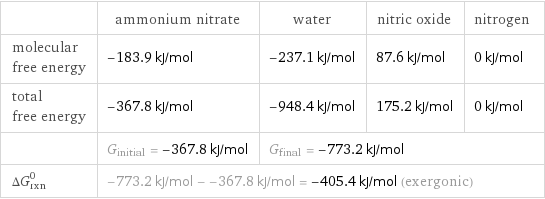
| ammonium nitrate | water | nitric oxide | nitrogen molecular free energy | -183.9 kJ/mol | -237.1 kJ/mol | 87.6 kJ/mol | 0 kJ/mol total free energy | -367.8 kJ/mol | -948.4 kJ/mol | 175.2 kJ/mol | 0 kJ/mol | G_initial = -367.8 kJ/mol | G_final = -773.2 kJ/mol | | ΔG_rxn^0 | -773.2 kJ/mol - -367.8 kJ/mol = -405.4 kJ/mol (exergonic) | | |
Equilibrium constant
![Construct the equilibrium constant, K, expression for: NH_4NO_3 ⟶ H_2O + NO + N_2 Plan: • Balance the chemical equation. • Determine the stoichiometric numbers. • Assemble the activity expression for each chemical species. • Use the activity expressions to build the equilibrium constant expression. Write the balanced chemical equation: 2 NH_4NO_3 ⟶ 4 H_2O + 2 NO + N_2 Assign stoichiometric numbers, ν_i, using the stoichiometric coefficients, c_i, from the balanced chemical equation in the following manner: ν_i = -c_i for reactants and ν_i = c_i for products: chemical species | c_i | ν_i NH_4NO_3 | 2 | -2 H_2O | 4 | 4 NO | 2 | 2 N_2 | 1 | 1 Assemble the activity expressions accounting for the state of matter and ν_i: chemical species | c_i | ν_i | activity expression NH_4NO_3 | 2 | -2 | ([NH4NO3])^(-2) H_2O | 4 | 4 | ([H2O])^4 NO | 2 | 2 | ([NO])^2 N_2 | 1 | 1 | [N2] The equilibrium constant symbol in the concentration basis is: K_c Mulitply the activity expressions to arrive at the K_c expression: Answer: | | K_c = ([NH4NO3])^(-2) ([H2O])^4 ([NO])^2 [N2] = (([H2O])^4 ([NO])^2 [N2])/([NH4NO3])^2](../image_source/2a2e49324507b6f67be3d48b0656f31c.png)
Construct the equilibrium constant, K, expression for: NH_4NO_3 ⟶ H_2O + NO + N_2 Plan: • Balance the chemical equation. • Determine the stoichiometric numbers. • Assemble the activity expression for each chemical species. • Use the activity expressions to build the equilibrium constant expression. Write the balanced chemical equation: 2 NH_4NO_3 ⟶ 4 H_2O + 2 NO + N_2 Assign stoichiometric numbers, ν_i, using the stoichiometric coefficients, c_i, from the balanced chemical equation in the following manner: ν_i = -c_i for reactants and ν_i = c_i for products: chemical species | c_i | ν_i NH_4NO_3 | 2 | -2 H_2O | 4 | 4 NO | 2 | 2 N_2 | 1 | 1 Assemble the activity expressions accounting for the state of matter and ν_i: chemical species | c_i | ν_i | activity expression NH_4NO_3 | 2 | -2 | ([NH4NO3])^(-2) H_2O | 4 | 4 | ([H2O])^4 NO | 2 | 2 | ([NO])^2 N_2 | 1 | 1 | [N2] The equilibrium constant symbol in the concentration basis is: K_c Mulitply the activity expressions to arrive at the K_c expression: Answer: | | K_c = ([NH4NO3])^(-2) ([H2O])^4 ([NO])^2 [N2] = (([H2O])^4 ([NO])^2 [N2])/([NH4NO3])^2
Rate of reaction
![Construct the rate of reaction expression for: NH_4NO_3 ⟶ H_2O + NO + N_2 Plan: • Balance the chemical equation. • Determine the stoichiometric numbers. • Assemble the rate term for each chemical species. • Write the rate of reaction expression. Write the balanced chemical equation: 2 NH_4NO_3 ⟶ 4 H_2O + 2 NO + N_2 Assign stoichiometric numbers, ν_i, using the stoichiometric coefficients, c_i, from the balanced chemical equation in the following manner: ν_i = -c_i for reactants and ν_i = c_i for products: chemical species | c_i | ν_i NH_4NO_3 | 2 | -2 H_2O | 4 | 4 NO | 2 | 2 N_2 | 1 | 1 The rate term for each chemical species, B_i, is 1/ν_i(Δ[B_i])/(Δt) where [B_i] is the amount concentration and t is time: chemical species | c_i | ν_i | rate term NH_4NO_3 | 2 | -2 | -1/2 (Δ[NH4NO3])/(Δt) H_2O | 4 | 4 | 1/4 (Δ[H2O])/(Δt) NO | 2 | 2 | 1/2 (Δ[NO])/(Δt) N_2 | 1 | 1 | (Δ[N2])/(Δt) (for infinitesimal rate of change, replace Δ with d) Set the rate terms equal to each other to arrive at the rate expression: Answer: | | rate = -1/2 (Δ[NH4NO3])/(Δt) = 1/4 (Δ[H2O])/(Δt) = 1/2 (Δ[NO])/(Δt) = (Δ[N2])/(Δt) (assuming constant volume and no accumulation of intermediates or side products)](../image_source/db540c08196d58040fbe20d7833de6ee.png)
Construct the rate of reaction expression for: NH_4NO_3 ⟶ H_2O + NO + N_2 Plan: • Balance the chemical equation. • Determine the stoichiometric numbers. • Assemble the rate term for each chemical species. • Write the rate of reaction expression. Write the balanced chemical equation: 2 NH_4NO_3 ⟶ 4 H_2O + 2 NO + N_2 Assign stoichiometric numbers, ν_i, using the stoichiometric coefficients, c_i, from the balanced chemical equation in the following manner: ν_i = -c_i for reactants and ν_i = c_i for products: chemical species | c_i | ν_i NH_4NO_3 | 2 | -2 H_2O | 4 | 4 NO | 2 | 2 N_2 | 1 | 1 The rate term for each chemical species, B_i, is 1/ν_i(Δ[B_i])/(Δt) where [B_i] is the amount concentration and t is time: chemical species | c_i | ν_i | rate term NH_4NO_3 | 2 | -2 | -1/2 (Δ[NH4NO3])/(Δt) H_2O | 4 | 4 | 1/4 (Δ[H2O])/(Δt) NO | 2 | 2 | 1/2 (Δ[NO])/(Δt) N_2 | 1 | 1 | (Δ[N2])/(Δt) (for infinitesimal rate of change, replace Δ with d) Set the rate terms equal to each other to arrive at the rate expression: Answer: | | rate = -1/2 (Δ[NH4NO3])/(Δt) = 1/4 (Δ[H2O])/(Δt) = 1/2 (Δ[NO])/(Δt) = (Δ[N2])/(Δt) (assuming constant volume and no accumulation of intermediates or side products)
Chemical names and formulas
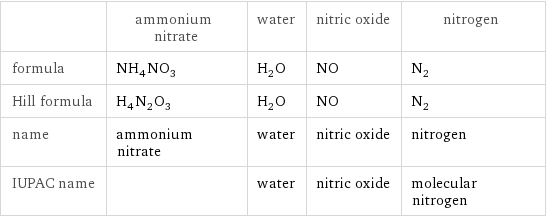
| ammonium nitrate | water | nitric oxide | nitrogen formula | NH_4NO_3 | H_2O | NO | N_2 Hill formula | H_4N_2O_3 | H_2O | NO | N_2 name | ammonium nitrate | water | nitric oxide | nitrogen IUPAC name | | water | nitric oxide | molecular nitrogen
Substance properties
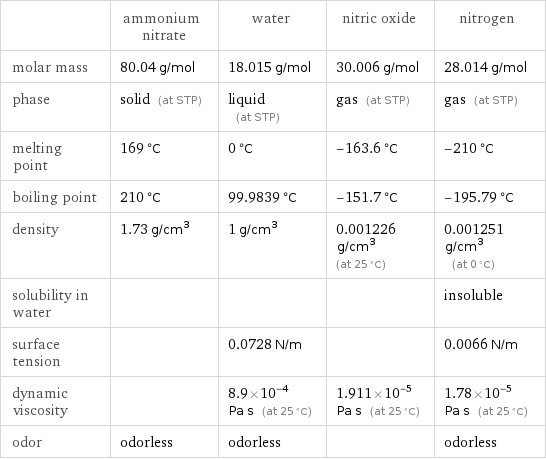
| ammonium nitrate | water | nitric oxide | nitrogen molar mass | 80.04 g/mol | 18.015 g/mol | 30.006 g/mol | 28.014 g/mol phase | solid (at STP) | liquid (at STP) | gas (at STP) | gas (at STP) melting point | 169 °C | 0 °C | -163.6 °C | -210 °C boiling point | 210 °C | 99.9839 °C | -151.7 °C | -195.79 °C density | 1.73 g/cm^3 | 1 g/cm^3 | 0.001226 g/cm^3 (at 25 °C) | 0.001251 g/cm^3 (at 0 °C) solubility in water | | | | insoluble surface tension | | 0.0728 N/m | | 0.0066 N/m dynamic viscosity | | 8.9×10^-4 Pa s (at 25 °C) | 1.911×10^-5 Pa s (at 25 °C) | 1.78×10^-5 Pa s (at 25 °C) odor | odorless | odorless | | odorless
Units
